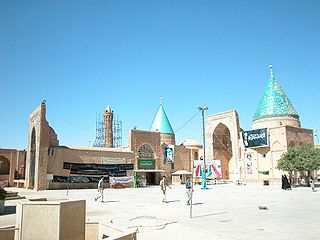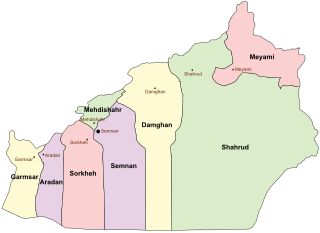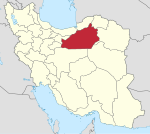
Semnan province is one of the 31 Provinces of Iran. It is in the north of the country. Its capital is the city of Semnan.

Semnan is a city in the Central District of Semnan County, Semnan province, Iran, serving as capital of the province, the county and the district. The city is on the alluvial fan of the Golrudbar creek in the north-central part of the country, 216 km east of Tehran and 640 km west of Mashhad. With a population of 185,129 people in 2016, Semnan is the most populous city in the province and the hub of the Semnani language, a sub-branch of the Iranian languages spoken to the north. It is home to the Semnani ethnic group.

Damghan is a city in the Central District of Damghan County, Semnan province, Iran, serving as capital of both the county and the district.

Bastam is a city in, and the capital of, Bastam District of Shahrud County, Semnan province, Iran.

Abu 'l-Hassan Ali ibn Ahmad ibn Salmān al-Kharaqāni was one of the master Sufis of Islam. He was born in 963 of Persian parents in Khorasan in the village of Qaleh Now-e Kharaqan and died on the day of Ashura in 1033.

Shahrud County is in Semnan province, Iran. Its capital is the city of Shahrud.

Savadkuh County is in Mazandaran province, Iran. Its capital is the city of Pol-e Sefid.
Dibaj is a city in the Central District of Damghan County, Semnan province, Iran. It was the administrative center for Rudbar Rural District before being transferred to the city of Kalateh Rudbar.

The Shahrood or Shah-Rud, also translated as Shah River, is a river of northern Iran.

The 856 Damghan earthquake or the 856 Qumis earthquake occurred on 22 December 856. The earthquake had an estimated magnitude of 7.9, and a maximum intensity of X (Extreme) on the Mercalli intensity scale. The meizoseismal area extended for about 350 kilometres (220 mi) along the southern edge of the eastern Alborz mountains of present-day Iran including parts of Tabaristan and Gorgan. The earthquake's epicenter is estimated to be close to the city of Damghan, which was then the capital of the Persian province of Qumis. It caused approximately 200,000 deaths and is listed by the USGS as the sixth deadliest earthquake in recorded history. This death toll has been debated.
Beyarjomand is a city in, and the capital of, Beyarjomand District of Shahrud County, Semnan province, Iran. It was the capital of Beyarjomand Rural District before its capital was transferred to the village of Khan Khvodi.
Kalateh-ye Khij is a city in Bastam District of Shahrud County, Semnan province, Iran. It was the administrative center for Kalat-e Hay-ye Gharbi Rural District until transferred to the village of Khij.
Mojen is a city in Bastam District of Shahrud County, Semnan province, Iran.
Bastam District is in Shahrud County, Semnan province, Iran. Its capital is the city of Bastam.
Kharqan Rural District is in Bastam District of Shahrud County, Semnan province, Iran. Its capital is the village of Qaleh Now-e Kharaqan.
Kalat-e Hay-ye Gharbi Rural District is in Bastam District of Shahrud County, Semnan province, Iran. Its capital is the village of Khij. The rural district was previously administered from the city of Kalateh-ye Khij.
Khij is a village in, and the capital of, Kalat-e Hay-ye Gharbi Rural District of Bastam District, Shahrud County, Semnan province, Iran. The rural district was previously administered from the city of Kalateh-ye Khij.
Deh Kheyr is a village in Kharqan Rural District, Bastam District, Shahrud County, Semnan Province, Iran. At the 2006 census, its population was 182, in 39 families.
Miqan is a village in Kharqan Rural District of Bastam District, Shahrud County, Semnan province, Iran.
Qaleh Now-e Kharaqan is a village in, and the capital of, Kharqan Rural District of Bastam District, Shahrud County, Semnan province, Iran.


















